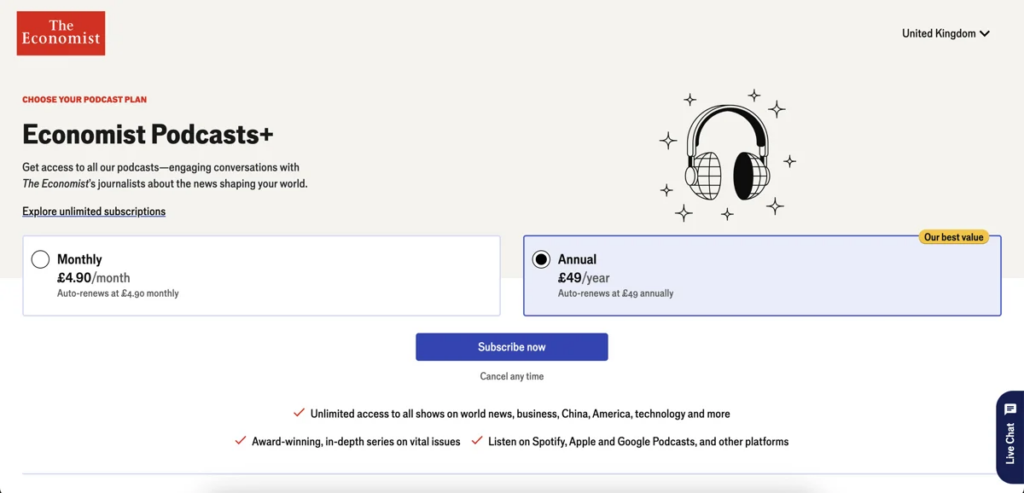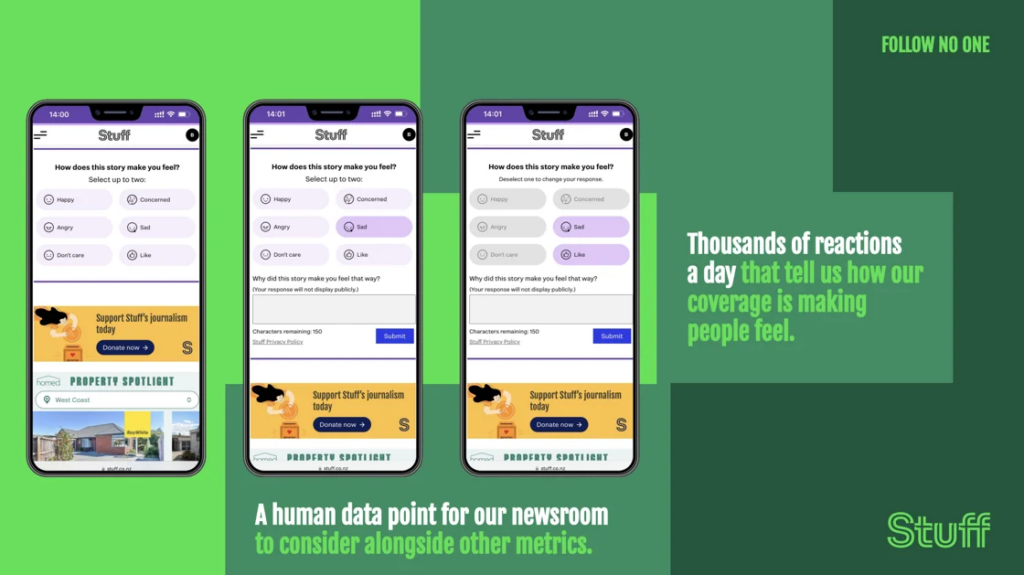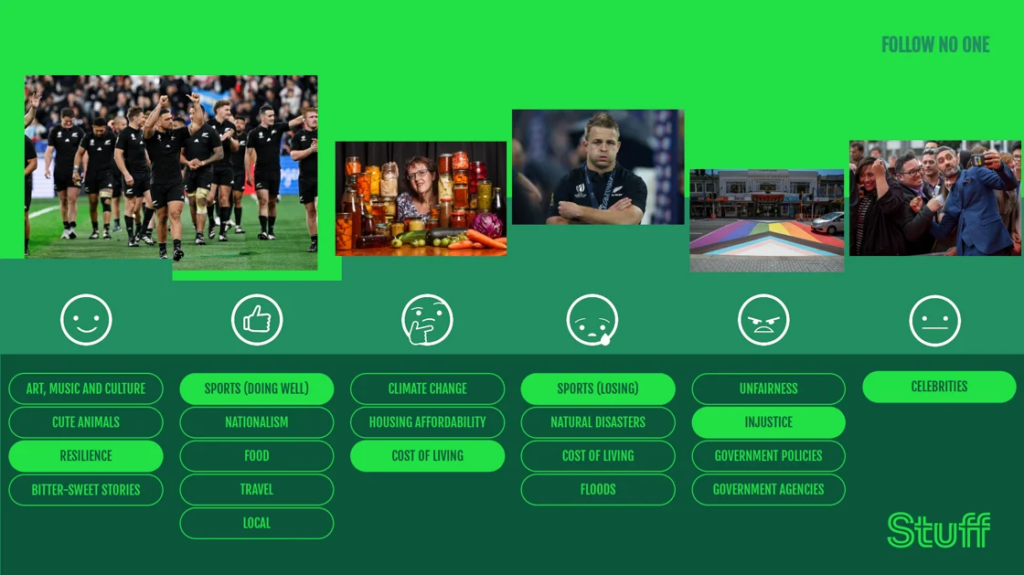

You're reading The Audiencers' newsletter #37, sent out on May 2nd, 2023. To receive future newsletters straight to your inbox every two weeks, sign up here.
The tour doesn’t stop there
If 3 festivals in 2024 wasn’t enough already, we’re now getting ready for London (#2), with some incredibly intelligent speakers and a surprise that I’m very excited about!
So, if you’re keen to join, save June 21st in your diary and keep an eye out for the registration page launch coming in the next week or so 🎉
In today’s newsletter:
- Cookies walls: with tightening regulations, these publishers are already using this strategy to increase consent rates
- Podcasts are worth paying for too! How The Economist put their podcasts behind a paywall
- Join us at FIPP’s conference by the sea in sunny Lisbon
- Sentiment trackers on content: how New Zealand’s Stuff is tackling news avoidance
- Content to add to your reading list
With tightening regulations, these publishers are already using Cookie Walls to increase consent rates
Cookies are a pretty hot topic at the moment, and with companies being faced with constantly changing, ever tightening restrictions that differ around the world, it’s hard to keep up.
On the one hand, it’s great to see readers having more control over the use of their data.
However, tightening consent regulations are creating a significant hurdle for publishers, especially the legislations that make declining consent even easier than ever.
For instance, one of the first countries to make a move in this direction was France where, in Spring 2021, the national data protection agency, the CNIL (National Commission on Informatics and Liberty), declared that it should be as easy to decline cookies as it is to accept them.
Specifically, the “Decline” consent button on the cookie banner (the thing you see when you first arrive on a website) should be on the same level as the “Accept” option.
A similar kind of regulation has been introduced in Germany and more recently in Spain. The UK, and likely others, are set to follow suit…
The rise of cookie walls
Like all “walls”, a cookie wall asks for a value exchange, offering a reader two options:
- Accept cookies and continue to browse the website as normal
- Reject cookies but support the publisher in another way, such as by subscribing (the most popular option) or paying a one-time fee
Paris Match blocks on the content level – “Information has a cost.” – offering the options of accepting and continuing to the article, or subscribing.

Note that this cookie wall strategy is legal as long as the alternative option is cookie-free. I.e. you have to always offer the possibility to access your site without ever consenting.
Der Spiegel’s cookie wall is integrated into the consent banner, presented upon arriving on the website. “Continue reading with ads, or read ad-free with a subscription”.

(Translated from German by Google)
> Find more cookie wall benchmarks on The Audiencers
Podcasts are content worth paying for too!
Last year, The Economist announced that they were putting podcasts behind a paywall…
As Seema Hope shared, the team realized that it didn’t make a lot of sense to give away lots of quality journalism without charge (9 podcasts, to be precise), whilst also having a hard paywall on written content.
The goal: monetize podcasts and bring these audiences to The Economist’s owned platform
The challenge: hard to make people pay for podcasts, they were starting blind (no benchmarks, internally and externally), the question of whether consumers ready for this, no pricing anchors, what would the customer journey look like, heavy reliance on 3rd part platform data, saturated news podcast market…
But a year later and the strategy is going strong! So what’s contributed to this success?
- Strong company foundations – confidence (market trends, already a loyal and growing audience), content (award winning content) and culture (collective responsibility, acceptance that it’s a test and learn process)
- Involve people across the business – communicate internally on why you’re doing this, share research and outputs, getting the product as good as it can be
- Research (a lot of research!) – around 7,500 minutes of consumer interviews, 15,000 surveyed globally in various formats
- Focus on gaining a diversified audience – a low cost entry point to the products has attracted for young subs
- Unlocked data – moving audio to their own platforms has increased first party data

Tackling news avoidance with a sentiment tracker
The New Zealand publication, Stuff, is tackling news avoidance with a unique strategy – a sentiment tracker to ask readers how the article made them feel.
Ben Haywood, Chief Product Officer, shared how they believe mindful news consumption is a good thing and that they want to play a role in helping people have a better relationship with the news.
The key questions:
> How might they give people more control over their news experience?
> How might they ensure that people trust Stuff with their mood & wellbeing?
> If people are choosing fewer sources to get their news, how can they make sure Stuff is one of those sources?
How can they find the answers?
> By understanding how their stories are making people feel
Page views and audience numbers weren’t going to do this, only more human data would. So, they launched the sentiment tracker:

This tracker appears at the bottom of every article (although newsrooms can turn it off for more sensitive topics), giving readers the chance to vote in a single click for which emotion best matches how they feel after reading the article.
Thanks to the simple question and ease-to-reply, this is generating thousands of reactions every day.
What is it telling them?

Unsurprisingly, people feel sad when the All Blacks lose, and happy when they win!
But there’s also a real rich level of data here too that are helping Stuff provide more thoughtful recommendations based on how people feel, both on the article level and topic level, thanks to an interactive dashboard.
For instance, if they see that readers are feeling very down after a tough climate story, the publisher can recommend articles that are a bit more solution-focused, or elicit a happier emotion.
Content to add to your reading list:
- How to make a hard paywall dynamic
- Changing the way we do paid: how L’Équipe halved subscriber acquisition costs whilst increasing both attribution and last-click subscriptions
- An oldie but essential one by Tomas Baekdal – Lifetime values are critical to subscription success
The Audiencers’ newsletter: from professionals to professionals
Sign up to our newsletter – real-life examples, expert points of view and inspirations from publishers around the world to help you do your job better. Sent every two weeks.


